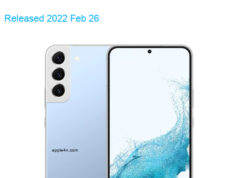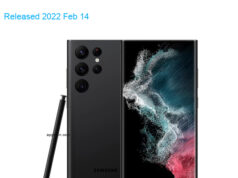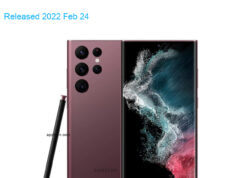| Brand | |
| Model | Pixel 7 Pro 5G UW TD-LTE JP 256GB GFE4J |
| Released | 2022 Oct 13 |
| Announced | 2022 Oct 6 |
| Hardware Designer | |
| Manufacturer | Foxconn |
| Codename | Google Cheetah |
| General Extras | Haptic touch feedback |
| Device Category | Smartphone |
| Width | 76.6 mm |
| Height | 162.9 mm |
| Depth | 8.9 mm |
| Dimensions | 3.02×6.41×0.35 inches |
| Mass | 212 g |
| Platform | Android |
| Operating System | Google Android 13 (Tiramisu) |
| Software Extras | Voice Command , Navigation software , Augmented Reality (AR) , Intelligent personal assistant , Voice Recognition , Face Recognition |
| CPU Clock | 2850 MHz |
| CPU | Samsung Google Tensor G2 GS201 S5P9855 (Cloudripper), 2022, 64 bit, octa-core, 3072 Kbyte L2, 4096 Kbyte L3, 5 nm, ARM Mali-G710 GPU |
| RAM Type | LPDDR5 SDRAM |
| RAM Capacity (converted) | 12 GiB RAM |
| Non-volatile Memory Interface | UFS 3.1 |
| Non-volatile Memory Capacity (converted) | 256 GB ROM |
| Display Hole | 1-hole |
| Display Diagonal | 170 mm |
| Resolution | 1440×3120 |
| Horizontal Full Bezel Width | 5.36 mm |
| Display Area Utilization | 88.1% |
| Pixel Density | 513 PPI |
| Display Type | AM-OLED display |
| Number of Display Scales | 16.8M |
| Display Refresh Rate | 120 Hz |
| Scratch Resistant Screen | Gorilla Glass Victus |
| Graphical Controller | ARM Mali-G710MP7 |
| A/V Out | No |
| Microphone(s) | 3 |
| Loudspeaker(s): | stereo |
| Audio Output: | USB Type-C |
| Supported Cellular Bands | GSM850 , GSM900 , GSM1800 , GSM1900 , UMTS2100 (B1) , UMTS1900 (B2) , UMTS1700/2100 (B4) , UMTS850 (B5) , UMTS800 (B6) , UMTS900 (B8) , UMTS800 (B19) , LTE2100 (B1) , LTE1900 (B2) , LTE1800 (B3) , LTE1700/2100 (B4) , LTE850 (B5) , LTE2600 (B7) , LTE900 (B8) , LTE700 (B12) , LTE700 (B13) , LTE700 (B14) , LTE700 (B17) , LTE800 (B18) , LTE800 (B19) , LTE800 (B20) , LTE1900 (B25) , LTE850 (B26) , LTE700 (B28) , LTE700 (B29) , LTE2300 (B30) , TD-LTE2600 (B38) , TD-LTE1900 (B39) , TD-LTE2300 (B40) , TD-LTE2500 (B41) , TD-LTE3500 (B42) , TD-LTE5900 (B46) , TD-LTE3600 (B48) , LTE1700/2100 (B66) , LTE600 (B71) , NR2100 (N1) , NR1900 (N2) , NR1800 (N3) , NR850 (N5) , NR2600 (N7) , NR900 (N8) , NR 700 (N12) , NR700 (N14) , NR800 (N20) , NR1900 (N25) , NR700 (N28) , NR2300 (N30) , TD-NR2600 (N38) , TD-NR2300 (N40) , TD-NR2500 (N41) , TD-NR3600 (N48) , NR1700/2100 (N66) , NR600 (N71) , TD-NR3700 (N77) , TD-NR3500 (N78) , TD-NR28G (N257) , TD-NR26G (N258) , TD-NR39G (N260) , TD-NR28G (N261) bands |
| Supported Cellular Data Links | GPRS , GPRS MSC33 , EDGE , UMTS , HSUPA , HSUPA 5.8 , HSDPA , HSPA+ 21.1 , DC-HSDPA 42.2 , LTE , LTE 100/50 , LTE 150/50 , LTE 225/50 , LTE 300/50 , LTE 300/75 , LTE 400/150 , LTE 1200/200 , NR 1500 , NR 2600 , NR 3700 , NR 4600 data links |
| SIM Card Slot | e-SIM , Nano-SIM (4FF) |
| Complementary Phone Services | Voice transmission , Voice speaker , Vibrate , Speakerphone , ANC , HD Voice , VoLTE , ViLTE |
| Sec. Supported Cellular Networks: | No |
| Touchscreen Type | Capacitive multi-touch screen |
| Expansion Interfaces | No |
| USB | USB 3.1 Gen 2 / 3.2 Gen 2×1 |
| USB Services | USB charging , USB fast charging , USB Host , USB OTG 1.3 , USB OTG 2.0 , USB PD , USB PD 2.0 , USB PD 3.0 |
| USB Connector | USB C reversible |
| Max. Charging Power | 30.0 W |
| Bluetooth | Bluetooth 5.2 |
| Wireless LAN | 802.11a , 802.11b , 802.11g , 802.11n , 802.11ac , 802.11ax |
| Wireless Services | Miracast , Wi-Fi Direct , Wi-Fi Tethering , Wi-Fi Calling |
| NFC | NFC A , NFC B , FeliCa |
| FM Radio Receiver | No |
| Complementary Satellite Services | Simultaneous GPS , A-GPS , Dual-frequency GPS , Geotagging , QuickGPS , QZSS |
| Supported GLONASS protocol(s) | L1OF |
| Supported Galileo service(s) | E1 |
| Supported BeiDou system (BDS) | B1I BeiDou receiver |
| Camera Placement | Rear |
| Camera Image Sensor | BSI CMOS |
| Image Sensor Pixel Size | 1.20 micrometer |
| Number of effective pixels | 50.1 MP camera |
| Aperture (W) | f/1.85 |
| Zoom | 5.0 x optical zoom |
| Focus | PD AF , Laser AF |
| Min. Equiv. Focal Length | 26 mm |
| Video Recording | 3840×2160 pixel |
| Flash | dual LED |
| Camera Extra Functions | EIS , EIS (video) , OIS , Pixel unification , HDR photo , HDR video , Red-eye reduction , Slow motion video , Burst mode , Touch focus , Macro mode , Panorama Photo , Face detection , Face tagging , Smile detection , Face retouch , Face retouch (video) , Intelligent scene detection |
| Aux. Camera Image Sensor | BSI CMOS |
| Aux. Cam. Image Sensor Pixel Size | 1.25 micrometer |
| Aux. Camera Number of Pixels | 12.0 MP aux. cam |
| Aux. Camera Aperture (W) | f/2.20 |
| Aux. Camera Extra Functions | HDR photo , Burst mode , Panorama Photo , Face detection , Face tagging , Smile detection , Face retouch , Face retouch (video) , Intelligent scene detection |
| Aux. 2 Camera Image Sensor | BSI CMOS |
| Aux. 2 Camera Number of Pixels | 48.0 MP aux. 2 cam |
| Aux. 2 Camera Aperture (W) | f/3.50 |
| Aux. 3 Camera Image Sensor | No |
| Aux. 4 Camera Image Sensor | No |
| Secondary Camera Placement | Front |
| Secondary Camera Sensor | BSI CMOS |
| Secondary Camera Number of pixels | 10.9 MP sec. cam |
| Secondary Aperture (W) | f/2.20 |
| Secondary Video Recording | 3840×2160 pixel |
| Secondary Camera Extra Functions | EIS , EIS (video) , HDR photo , Burst mode , Panorama Photo , Face detection , Face tagging , Smile detection , Face retouch |
| Sec. Aux. Cam. Image Sensor | No |
| Built-in compass | Yes |
| Built-in accelerometer | 3D accelerometer |
| Built-in gyroscope | 3D gyro |
| Additional sensors | Barometer , In-screen FP sensor , L sensor , P sensor |
| Protection from solid materials | 6 Totally protected from dust |
| Protection from liquids | 8 Protected against immersion beyond 1m of depth |
| Immersion into liquids (depth limit) | 150 cm |
| Immersion into liquids time limit | 30 min |
| Battery | Li-ion polymer (LiPo) |
| Nominal Battery Capacity | 5000 mAh battery |
| Estimated Battery Life | 28.0 hours |
| Wireless Charging | Qi , Qi reverse |
| Max. Wireless Charging Power | 23.0 W |
| Market Countries | Japan |
| Market Regions | Asia |
| Mobile Operator | SoftBank Corp. |
| Price | 949.96 USD |
| Added | 2025-02-08 |
Specifications data description of this 📱Google Pixel 7 Pro 5G UW TD-LTE JP 256GB GFE4J📱
Title: Google Pixel 7 Pro 5G UW TD-LTE JP 256GB GFE4J: A Comprehensive Specification Guide
Introduction:
Welcome to the world of Google’s latest and greatest flagship device, the Pixel 7 Pro 5G UW TD-LTE JP 256GB GFE4J. This smartphone is packed with features and specifications that make it one of the most powerful devices in the market. In this blog post, we will take a closer look at the specifications of the device and what it has in store for you.
Lineup:
The Google Pixel 7 Pro 5G UW TD-LTE JP 256GB GFE4J is part of the Pixel 7 lineup, which includes the standard Pixel 7 and the budget-friendly Pixel 7a. With the latest technology and cutting-edge design, the Pixel 7 Pro stands out as the premium device in the lineup.
Design:
The Pixel 7 Pro has a sleek and modern design with a 6.7-inch OLED display and a resolution of 3120 x 1440 pixels. The device is water and dust resistant with an IP68 rating, making it perfect for everyday use. Available in a variety of colors, the device is sure to turn heads.
Specifications:
🌐NETWORK: 5G UW TD-LTE JP, Bluetooth 5.2, NFC, GPS, Wi-Fi 6E
📅LAUNCH: October 2023
🏋️BODY: 162.9 x 76.6 x 8.9 mm, 212 g, IP68 dust/water resistant
🌈 DISPLAY: 6.7-inch OLED, 3120 x 1440 pixels
🤖 OS: Android 13
🛠️ CHIPSET: Google Tensor G2
🚀 CPU: Octa-core (2×2.8 GHz Cortex-X1 & 2×2.3 GHz Cortex-A76 & 4×1.8 GHz Cortex-A55)
🎮 GPU: Mali-G710
💪 CPU: Octa-core (1×3.2 GHz Cortex-A87 & 3×2.4 GHz Cortex-A55)
🖥️ GPU: Adreno 715
🧠 MEMORY: 12 GB RAM, 256 GB internal storage
📷 CAMERA: 50 MP (wide) + 12 MP (ultrawide) + 48 MP (telephoto)
🎥 CAMERA FEATURES: Dual-LED flash, HDR, panorama
🔈 SOUND: Stereo speakers, 3.5 mm jack
📡 COMMS: USB Type-C 3.1, NFC
🎁 FEATURES: Fingerprint (under display, optical), accelerometer, gyro, proximity, compass, barometer
🔋 BATTERY: 5000 mAh, Fast charging 33W
🔌 CHARGING FEATURES: USB Power Delivery 3.0, Fast Qi/PMA wireless charging
Conclusion:
In conclusion, the Google Pixel 7 Pro 5G UW TD-LTE JP 256GB GFE4J is a feature-packed device that is sure to impress. With its powerful chipset, large memory, and impressive camera system, the device is ideal for those who want a top-of-the-line smartphone. With its sleek design, long-lasting battery, and cutting-edge technology, the Pixel 7 Pro is a device that stands out from the crowd.
We invite you to leave a comment and share your thoughts on the Google Pixel 7 Pro 5G UW TD-LTE JP 256GB GFE4J. Let us know what you think of the device, and how it compares to other devices in the market. We would love to hear from you!







